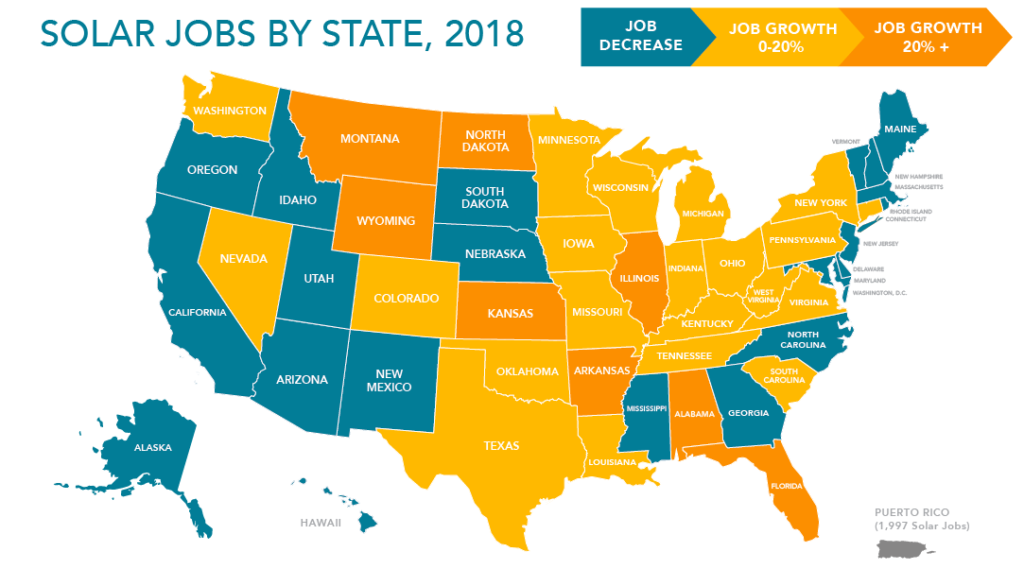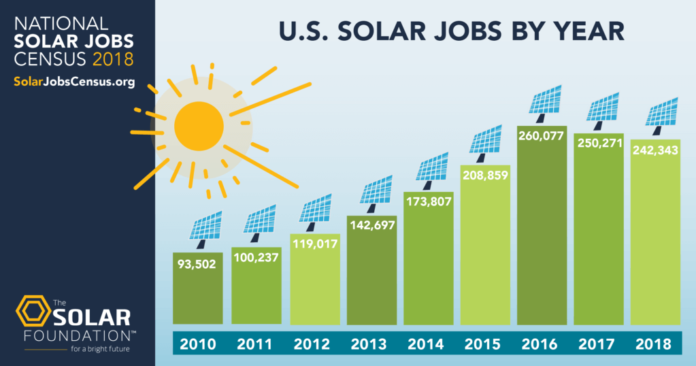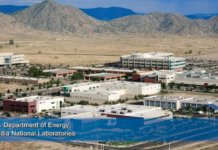The U.S. solar industry had 242,343 workers in 2018, representing a 3.2% decline from 2017, reports The Solar Foundation (TSF).
According to TSF’s National Solar Jobs Census 2018, the drop of nearly 8,000 jobs in 2018 marks the second year in a row that solar jobs declined after seven years of steady growth. At the same time, solar jobs increased in 29 states in 2018, including in many states that are considered to be emerging solar markets.
States with the highest employment gains include Florida, Illinois, Texas and New York. Other states that saw job growth include Ohio, Washington, Pennsylvania, Minnesota, Virginia and Tennessee.
“I’m proud that Minnesota continues to be a clean energy leader in the Midwest,” says Gov. Tim Walz, D-Minn. “While our solar workforce continued to grow last year, we need to do even more to develop and deploy renewable energy and continue to build a strong clean energy economy in Minnesota.”

TSF, a nonprofit educational and research organization, issues the National Solar Jobs Census each year to provide data on the U.S. solar workforce. Overall, solar employment has grown 159% since the first census was released in 2010 – adding nearly 150,000 jobs across all 50 states. Notably, the 2016 census found that the U.S. solar workforce grew at a historic pace: One out of every 50 new jobs in the country was in the solar industry, and the workforce grew by 25% over 2015.
For the first time, the 2018 National Solar Jobs Census includes job numbers for Puerto Rico, which had 1,997 solar workers in 2018. With Puerto Rico jobs included, the total number of U.S. solar jobs comes to 244,340.
“Despite two challenging years, the long-term outlook for this industry remains positive as even more Americans turn to low-cost solar energy and storage solutions to power their homes and businesses,” states Andrea Luecke, president and executive director of TSF. “However, it will take exceptional leadership at the federal, state and local levels to spur this growth and address the urgent challenge of climate change. Expanding solar energy and storage across America will create high-quality jobs, reduce carbon emissions, boost local economies, and build resilient and adaptive communities.”
Nationwide, the jobs decline in 2018 reflects a slowdown in installed solar capacity, according to the report. Solar companies delayed many utility-scale projects in late 2017 while awaiting the outcome of a petition for new tariffs on solar panels and cells. These delays led to reduced capacity growth and fewer jobs in the first three quarters of 2018, explains the nonprofit.
At the state level, policy challenges and a difficult business climate contributed to lower jobs numbers in some states with established solar markets. In other states, supportive policies and the rapidly declining cost of solar technologies helped drive an increase in employment in 2018, according to TSF.
The census is based on a survey of solar establishments that was conducted between September and October 2018. The survey included approximately 59,300 phone calls and over 49,000 emails. It was administered to 13,945 separate establishments, of which 2,697 provided full or substantially completed surveys.
Other key findings from the National Solar Jobs Census 2018 include as follows:
- Approximately 155,000 solar jobs, or two-thirds of the total, are in the installation and project development sector. Of these, about 87,000 jobs (56%) are focused on the residential market segment. The non-residential segment includes 46,000 jobs (30%), including about 12,500 jobs in community solar. The utility-scale market comprises 22,000 jobs (14%).
- Solar workforce demographics saw little change from the previous year. In 2018, women made up 26% of the workforce; Latino or Hispanic workers made up 17%; black or African American workers made up 8%; and Asian workers made up 9%.
- In 2018, 26% of solar establishments reported it was “very difficult” to find qualified candidates to fill open positions, representing a substantial increase from the 18% reporting such challenges in 2017.
- With a backlog of utility-scale projects and new policy incentives in key states, the outlook for solar jobs is expected to improve in 2019. Survey respondents predict that solar jobs will increase 7% in 2019, bringing the total to 259,400 jobs.
“This report highlights that in order to continue adding jobs, the solar industry is going to have to work harder to reduce the cost of going solar,” suggests Samuel Adeyemo, co-founder and chief operating officer of solar software company Aurora Solar. “Over the past seven years, this was accomplished by lowering module prices and democratizing financing. At Aurora, we believe that over the next seven years, it will come from reducing soft costs, such that solar gets to the point where it is the default option for most homes and businesses.”
“As one of the largest utility and commercial solar contractors in the U.S., we were impacted by several factors that caused market instability in 2018,” notes George Hershman, president of San Diego-based Swinerton Renewable Energy. “Tariffs on solar cells and modules, steel, and aluminum increased costs and impacted projects that were already in the pipeline. Despite these economic factors, we began 2019 with a robust pipeline that includes new projects in existing and emerging markets.”
In response to the report, Abigail Ross Hopper, president and CEO of the Solar Energy Industries Association, stresses the importance of federal action when it comes to the tariffs.
“The impact these unnecessary tariffs are having on America’s economy and its workers should not be ignored. The damage, from a decline in jobs to a decline in deployment, far outweighs any potential benefits the administration intended,” Hopper says. “We hope this data serves as a wake-up call to the administration that the Section 201 tariffs should be reversed before any more Americans lose their jobs.
“That said, despite this adversity, the U.S. solar industry’s long-term growth trajectories remain strong,” she continues. “Solar is entering new markets across the country each day, delivering communities well-paying jobs and billions of dollars in economic investment each year. The job growth outlined in this report in 29 states – many of them emerging solar markets – is a bright spot that we can build upon with smart policies in place.”
More on the report can be found here.




